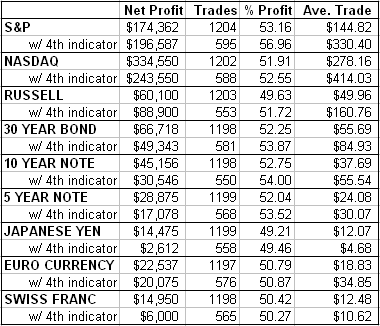I guess I spoke too soon. In my last entry, I said I would be able to improve the results of the combined three signal system through optimizing it in total. Turns out I was wrong. The existing figures are about as robust as I can find.
This is probably good news. Why should superior figures suddenly pop up just because we're looking at a total rather than a series of individual parts? I guess more seasoned analysts would have known that all along. This is probably exactly what we'd want for maximum faith in our results anyhow.
We've merely bypassed a first step. On to the next one â€" or, I should say the next step of many I so deem "the next one."
By adding one additional previously uncovered building block, the range expansion-contraction indicator, we can significantly improve the key profit per trade results. Click here to review the expansion-contraction indicator.
To review, we originally had plus one/minus one values assigned to three indicators:
1. Whether the previous daily close was above (bullish) or below (bearish) the 40-day moving average.
2. Whether the 2-day average was above the 5-day for a bullish reading, or vice versa if it was below.
3. Whether a buy was suggested by the highest 50-day close coming before the lowest 50-day close, or vice versa for sells.
We'd go in the direction of the majority. Now we'll assign a plus/minus value to one more indicator â€" the relationship of the close to the previous range and the average 10-day ranges. Specifically, the fourth indicator was that if today's range is less than the average 10-day range (including today's), then buy the open if today's close was higher than yesterday, or sell short the open if the close was lower. Since we now have four competing indicators, there will be net neutral days and we'll therefore be getting signals roughly half as often as before. Keep that in mind that as you observe mostly smaller net profit figures. Again though, the notable enhancement is in the win/loss ratio, and especially the average profit per trade. The first line of each market is the original three indicators and the second includes the additional fourth indicator.

Art Collins is the author of Market Beaters, a collection of interviews with renowned mechanical traders. He is currently working on a second volume. E-mail Art at artcollins@ameritech.net.